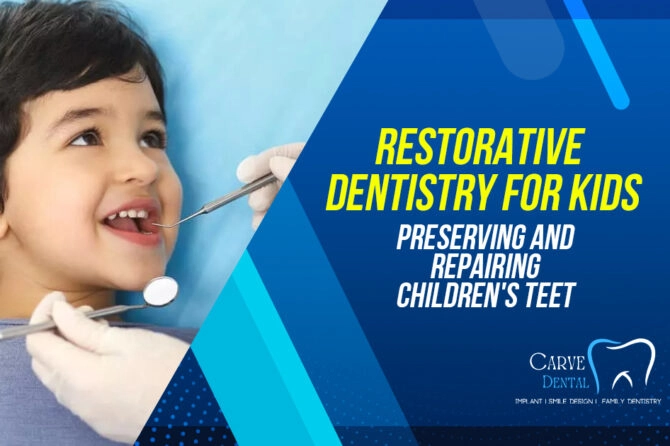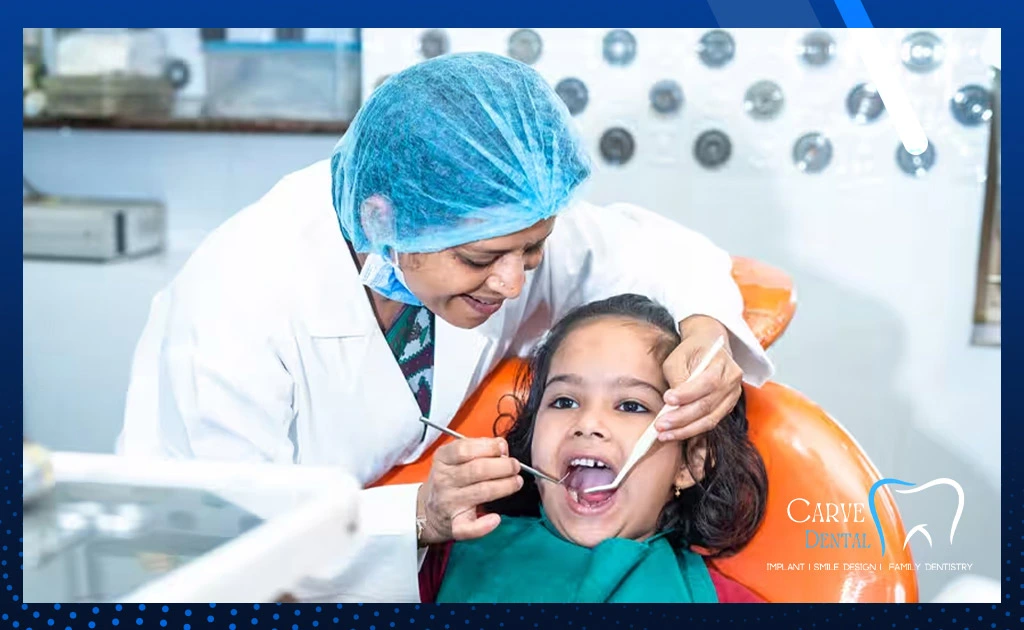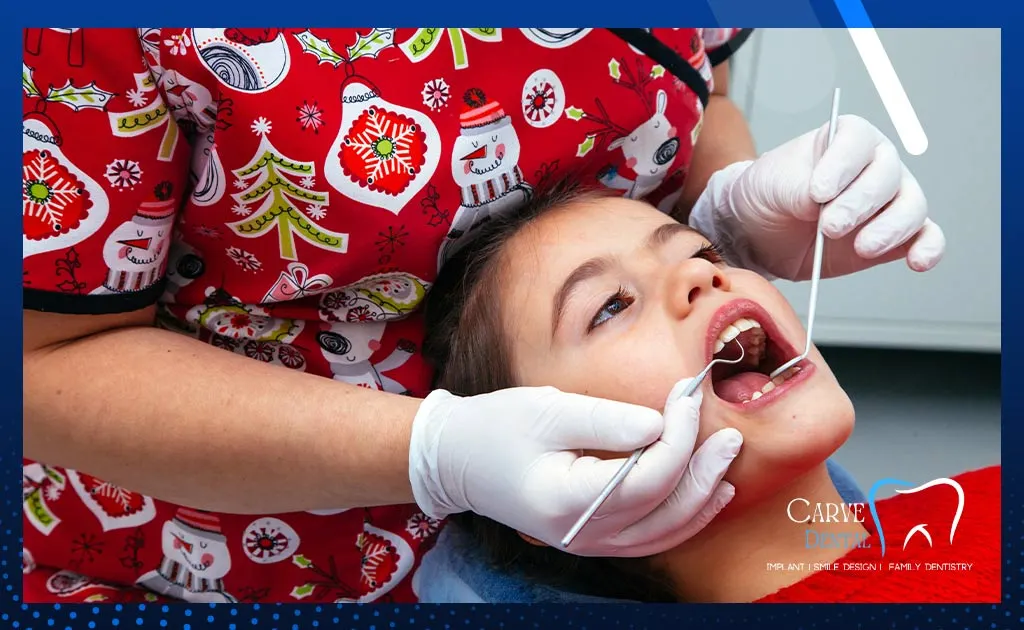
Restorative Dentistry for Kids: Preserving and Repairing Children’s Teeth
Restorative dentistry plays a crucial role in maintaining the oral health of children. From addressing common dental issues to preventing long-term complications, pediatric restorative dentistry ensures that children’s teeth remain healthy, functional, and aesthetically pleasing.
In this comprehensive guide, we will delve into various aspects of restorative dentistry for kids, including dental fillings, dental crowns, dental sealants, pulpotomy and pulpectomy procedures, space maintainers, preventive resin restorations, orthodontic considerations, and sedation dentistry.
By highlighting the importance of each procedure and providing valuable insights, we aim to educate parents and caregivers about the significance of early intervention and proper dental care for children.
Common Dental Issues in Children
Children commonly experience dental problems that require restorative treatment.
Tooth decay, cavities, dental trauma, and developmental abnormalities are prevalent issues among the pediatric population.
Tooth decay and cavities occur when bacteria in the mouth produce acids that erode the tooth enamel, leading to cavities.
Dental trauma, such as fractured or knocked-out teeth, can result from accidents during play or sports activities. Developmental abnormalities may include malocclusion (misalignment of teeth) or hypodontia (missing teeth).
Identifying and addressing these issues promptly is essential to prevent further damage and complications. Regular dental check-ups, good oral hygiene practices, and a healthy diet can significantly reduce the risk of these dental problems.
However, when such issues arise, restorative dentistry offers effective solutions to restore children’s dental health.

Importance of Pediatric Restorative Dentistry
Pediatric restorative dentistry plays a vital role in preserving and maintaining children’s oral health.
Beyond the immediate restoration of teeth, it ensures long-term dental well-being, prevents complications, and promotes healthy dental habits.
Ignoring dental problems in children can lead to pain, difficulty in eating and speaking, poor nutrition, and even negatively impact their overall development.
Restorative dentistry interventions not only restore damaged teeth but also help children regain their confidence and improve their quality of life.
Dental Fillings For Children
Dental fillings are a common restorative treatment for children with cavities.
When tooth decay occurs, the affected area needs to be cleaned, and the decayed tissue is removed.
Once the cavity is prepared, a dental filling material is used to restore the tooth’s structure.
For primary teeth, tooth-colored composite fillings are typically used, which blend seamlessly with the natural tooth color.
The process begins with numbing the area using local anesthesia to ensure the child’s comfort during the procedure.
The dentist carefully removes the decayed portion and applies the filling material, which is then hardened with a special light.
Dental fillings not only restore the tooth’s function but also prevent further decay by sealing off the cavity.
Pediatric Dental Crowns
- Restoring Function: Pediatric dental crowns are used to restore severely decayed or damaged teeth in children. These crowns provide strength and stability, allowing children to chew, speak, and bite properly. By restoring function, dental crowns ensure that children can enjoy a healthy and balanced diet while maintaining proper oral hygiene.
- Preventing Further Damage: Severely decayed or damaged teeth in children are more susceptible to additional harm. Dental crowns act as protective caps, covering the entire visible portion of the tooth, and preventing further damage or decay. This helps to preserve the tooth structure and avoid the need for more invasive treatments such as extractions.
- Long-Term Durability: Pediatric dental crowns are designed to withstand the unique challenges faced by children’s teeth. They are typically made from durable materials such as stainless steel or tooth-colored ceramic. These materials offer excellent strength and durability, ensuring that the dental crowns can withstand the forces of chewing and biting for an extended period.
- Aesthetically Pleasing: Dental crowns can be made to match the color and appearance of the child’s natural teeth, providing an aesthetically pleasing result. This helps to restore the child’s confidence in their smile and enhances their self-esteem.
- Maintaining Space for Permanent Teeth: Primary teeth play a crucial role in maintaining proper spacing for permanent teeth. When primary teeth are lost prematurely due to decay or damage, dental crowns can help preserve the space until the permanent teeth are ready to erupt. This ensures that the permanent teeth have enough room to come in properly, reducing the need for orthodontic intervention later.
Pediatric dental crowns offer numerous benefits in restoring severely decayed or damaged teeth in children.
From restoring function and preventing further damage to providing long-term durability and maintaining space for permanent teeth, dental crowns play a vital role in ensuring the oral health and overall well-being of children.
Dental Sealants
Dental sealants are a preventive measure used to protect children’s molars from tooth decay. These thin, protective coatings are applied to the chewing surfaces of the molars, creating a barrier against decay-causing factors.
Molars have deep grooves and pits where food particles and bacteria can easily accumulate, making them more prone to cavities.
Dental sealants act as a barrier, sealing off these vulnerable areas and protecting the teeth from decay.
The dentist cleans and dries the tooth surface, applies the sealant material, and uses a special light to bond it securely.
Dental sealants can significantly reduce the risk of cavities in children’s molars, providing added protection to their developing teeth.

Pulpotomy and Pulpectomy in Pediatric Dentistry
When baby teeth become severely decayed or infected, pulpotomy and pulpectomy procedures may be necessary to save them until they naturally fall out.
A pulpotomy involves removing the infected part of the pulp (nerve tissue) from the crown portion of the tooth while leaving the healthy pulp intact in the roots.
This procedure is typically performed on primary teeth with extensive decay. In cases where the infection has spread to the tooth roots, a pulpectomy is performed.
It involves the complete removal of the infected pulp from both the crown and root canals, followed by filling the canals with a biocompatible material.
These procedures relieve pain and prevent the spread of infection, allowing the primary teeth to maintain their function until they are naturally replaced by permanent teeth.
Space Maintainers
Space maintainers are devices used in pediatric dentistry to preserve the space left by prematurely lost primary teeth.
When primary teeth are lost too early, the surrounding teeth may shift and occupy the vacant space, causing problems with the eruption of permanent teeth.
Removable space maintainers are similar to orthodontic retainers and can be taken out for cleaning, while fixed space maintainers are cemented in place. These devices are custom-made to fit the child’s mouth and are carefully monitored by the dentist to ensure proper function and comfort.
Preventive Resin Restorations
Preventive resin restorations, also known as dental bonding, are used to repair minor tooth fractures and improve aesthetics in children.
This procedure involves applying a tooth-colored resin material to the affected tooth and bonding it with a special light.
Preventive resin restorations are an effective solution for small chips, cracks, or areas of enamel erosion in children’s teeth.
They help restore the tooth’s integrity, prevent further damage, and enhance its appearance.
Dental bonding is a conservative approach that requires minimal tooth preparation, making it a suitable option for pediatric restorative dentistry.

Orthodontic Considerations in Restorative Dentistry For Children
- Comprehensive Treatment Planning: When restorative dental procedures and orthodontic treatment plans coincide, a comprehensive approach is essential. The coordination between orthodontists and restorative dentists ensures that the child receives the most effective and efficient treatment possible. This collaborative effort allows for proper sequencing and timing of procedures, optimizing the overall outcome.
- Preparing the Foundation: Restorative dental procedures often play a critical role in preparing the foundation for orthodontic treatment. For instance, dental crowns or fillings may be necessary to restore decayed or damaged teeth before the initiation of orthodontic treatment. By addressing restorative needs first, orthodontists can work with a stable and healthy dentition, enhancing the success of orthodontic interventions.
- Coordinating with Braces or Aligners: Restorative dentistry can seamlessly integrate with orthodontic appliances like braces or aligners. For example, dental crowns can be placed on teeth that require additional support during orthodontic movement. In some cases, orthodontic treatment may be paused temporarily to accommodate restorative procedures such as placing dental implants or performing extractions.
- Achieving Optimal Aesthetics: Restorative dentistry can enhance the aesthetic outcomes of orthodontic treatment. In cases where significant tooth damage or discoloration exists, restorative procedures like dental bonding or veneers can be utilized to improve the appearance of teeth during or after orthodontic treatment. This comprehensive approach ensures that the child achieves not only a well-aligned bite but also a beautiful smile.
- Long-Term Stability: Restorative dentistry plays a vital role in providing long-term stability after orthodontic treatment. Procedures such as dental crowns or bridges may be necessary to support and protect teeth that have been realigned. These restorations help maintain the alignment achieved through orthodontic treatment and ensure a functional and aesthetically pleasing smile.
The coordination between orthodontics and restorative dentistry is crucial for children requiring both types of treatment.
Comprehensive treatment planning, addressing restorative needs before or during orthodontic treatment, and integrating restorations with orthodontic appliances all contribute to optimal results.
By considering both aspects of care, children can achieve not only a properly aligned bite but also a healthy, stable, and beautiful smile.
Conclusion
Restorative dentistry plays a vital role in preserving and repairing children’s teeth, promoting their oral health, and preventing long-term complications.
By addressing common dental issues in children, such as tooth decay, cavities, dental trauma, and developmental abnormalities, pediatric restorative dentistry ensures that children maintain healthy, functional, and aesthetically pleasing smiles.
Procedures like dental fillings, dental crowns, dental sealants, pulpotomy and pulpectomy, space maintainers, preventive resin restorations, and orthodontic considerations work together to provide comprehensive care for children’s dental needs.
With the support of sedation dentistry techniques, children can receive the necessary treatments comfortably and without anxiety.
By emphasizing early intervention, proper dental care, and coordination between restorative dentistry and orthodontics, parents and caregivers can empower their children to have a lifetime of excellent oral health.
FAQs
What is Restorative Dentistry For Kids?
Restorative dentistry for kids involves specialized dental procedures that focus on preserving and repairing children’s teeth, addressing issues like tooth decay, cavities, and damage to ensure their long-term health and functionality.
At What Age Should My Child Start Receiving Restorative Dental Treatments?
Restorative dental treatments can be necessary as soon as a child’s primary teeth start developing dental problems. It is crucial to address these issues early to prevent further damage and maintain good oral health.
Are Restorative Dental Procedures Safe For Children?
Yes, restorative dental procedures for children are safe when performed by qualified pediatric dentists. They use age-appropriate techniques, materials, and anesthesia to ensure the comfort and well-being of the child during the treatment.
How Long Do Restorations Last in Children’s Teeth?
The lifespan of restorations in children’s teeth varies depending on factors like the type of restoration, oral hygiene practices, and individual oral health. With proper care and regular dental check-ups, restorations can last several years before potential replacement.
Can Restorative Dentistry Interfere With Orthodontic Treatment For Children?
Restorative dentistry can complement orthodontic treatment in children. By coordinating treatment plans, restorative procedures can be performed before, during, or after orthodontic interventions to ensure optimal oral health, aesthetics, and alignment.
Leave a reply
Leave a reply